Aquariums are not just about keeping fish; they’re about creating a captivating underwater world right in your living room. A well-stocked aquarium can be a stunning centerpiece, a conversation starter, and a peaceful retreat all in one. But the key to achieving this lies in the selection of the right fish.
In this guide, we’re going to introduce you to 27 most colorful freshwater fish species that are not only a feast for the eyes but also ideal tank mates for each other. These fish species have been carefully selected for their compatibility, ensuring that your aquarium remains a peaceful community where every inhabitant thrives.
Whether you’re a seasoned aquarist or a beginner looking to dip your toes into the world of fishkeeping, this list will serve as your ultimate guide. From the dazzling Neon Tetra to the striking Gourami, these freshwater fish species will add a splash of color and life to your aquarium. According to a 2023 survey by the American Pet Products Association, approximately 11.8 million U.S. households own freshwater fish, making them the third most popular pet after dogs and cats.
So, let’s dive in and explore the world of these vibrant aquatic creatures. Remember, while aesthetics are important, the well-being of your fish should always be the top priority. Keeping colorful fish is not just about creating a beautiful display; it’s about fostering a thriving ecosystem where each species can exhibit its natural behaviors and live a healthy life. The right combination of these 27 species can transform your aquarium into a mesmerizing underwater rainbow that will captivate viewers for hours.
Table of Contents
1. Neon Tetra
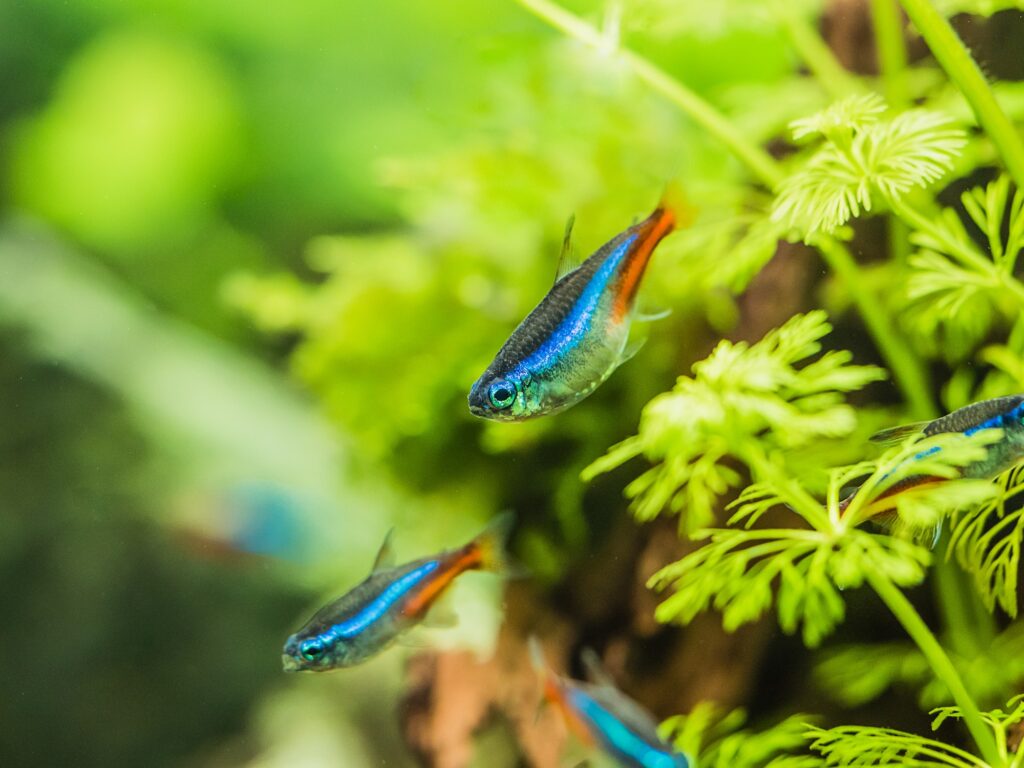
The Neon Tetra is a member of the Characidae family and is native to South American freshwater habitats. In the 1930s, these small fish, with their vibrant colors and peaceful temperament, were introduced to the United States, captivating the hearts of aquarists who quickly fell in love with them.
| Scientific Name | Paracheirodon innesi |
| Common/Market Names | Neon Tetra |
| Price Range | $1 – $2 per fish |
| Care Level | Easy |
| Breeding Level | Moderate |
| Behavior | Peaceful, schooling fish |
| Life Span | 5 – 10 years |
| Max Size | 1.5 inches |
| Water Volume | Minimum 10 gallons for a school |
2. Cardinal Tetra
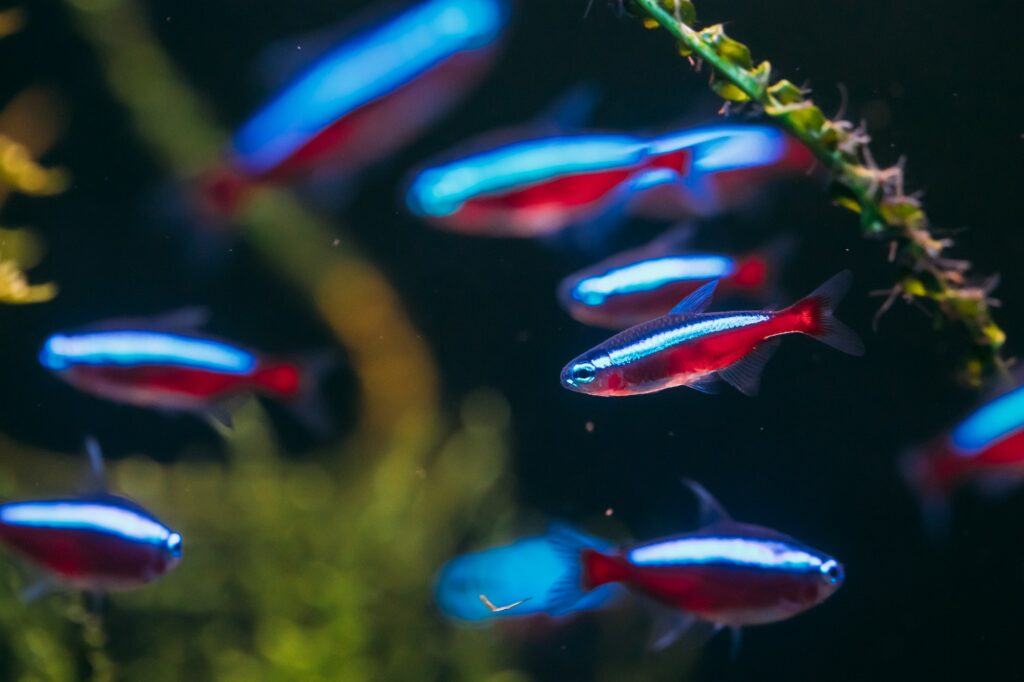
Cardinal Tetras, also part of the Characidae family, are native to the upper Orinoco and Negro Rivers in South America. They are often mistaken for Neon Tetras due to their similar appearance, but are distinguishable by their brighter and more extensive red coloration.
| Scientific Name | Paracheirodon axelrodi |
| Common/Market Names | Cardinal Tetra |
| Price Range | $2 – $5 per fish |
| Care Level | Intermediate |
| Breeding Level | Difficult |
| Behavior | Peaceful, schooling fish |
| Life Span | 4 – 5 years |
| Max Size | 2 inches |
| Water Volume | Minimum 10 gallons for a school |
3. Guppies
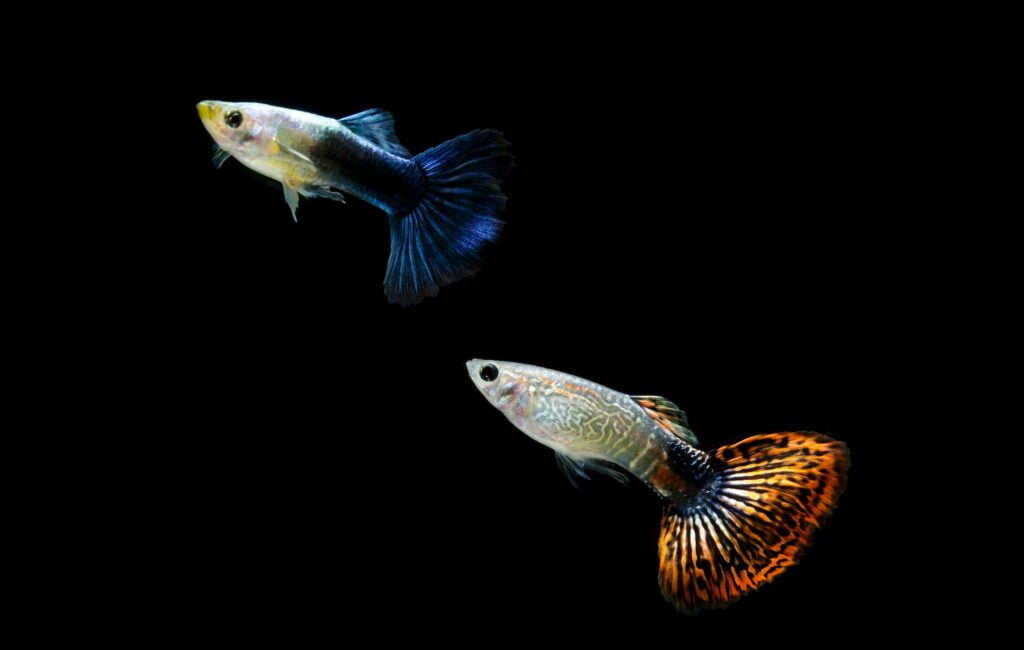
Guppies, belonging to the Poeciliidae family, are native to northeastern South America. Described for the first time by Wilhelm Carl Hartwig Peters in 1859, these magnificent creatures have captivated the hearts of aquarists worldwide. Admired for their incredible resilience, strikingly vivid hues, and effortless reproduction, they have quickly become a beloved choice among aquatic enthusiasts.
| Scientific Name | Poecilia reticulata |
| Common/Market Names | Guppy, Millionfish |
| Price Range | $3 – $20 per fish |
| Care Level | Easy |
| Breeding Level | Easy |
| Behavior | Peaceful, livebearer |
| Life Span | 2 – 3 years |
| Max Size | 2.5 inches |
| Water Volume | Minimum 5 gallons for a pair |
4. Mollies
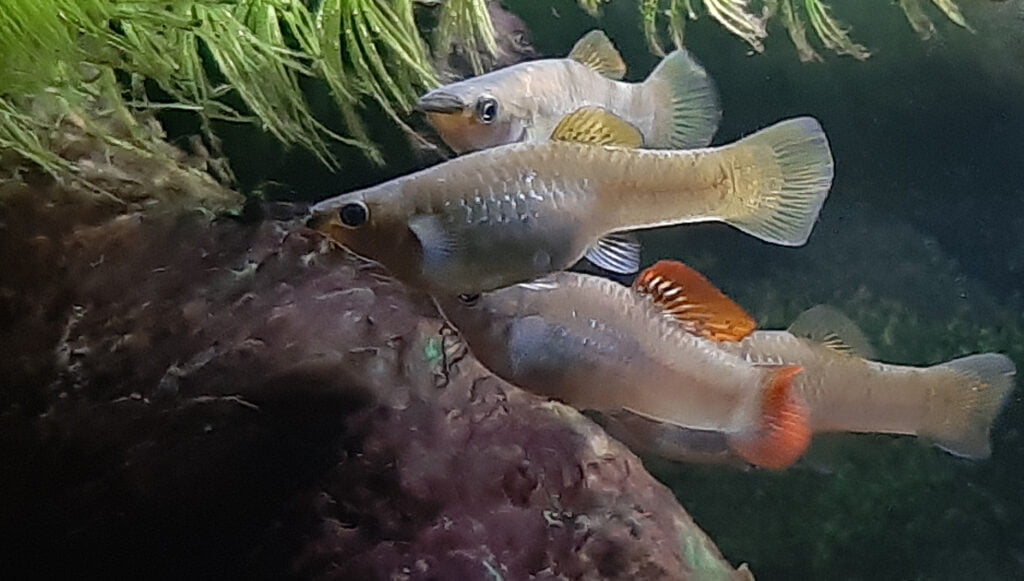
Mollies are part of the Poeciliidae family and are native to the Americas. Charles Alexandre Lesueur first described them in 1821. They quickly became popular in the aquarium trade because of their wide array of colors and patterns, as well as their ability to thrive in different water conditions.
| Scientific Name | Poecilia sphenops |
| Common/Market Names | Molly, Mollies |
| Price Range | $3 – $10 per fish |
| Care Level | Easy |
| Breeding Level | Easy |
| Behavior | Peaceful, livebearer |
| Life Span | 3 – 5 years |
| Max Size | 4.5 inches |
| Water Volume | Minimum 10 gallons for a pair |
5. Platies
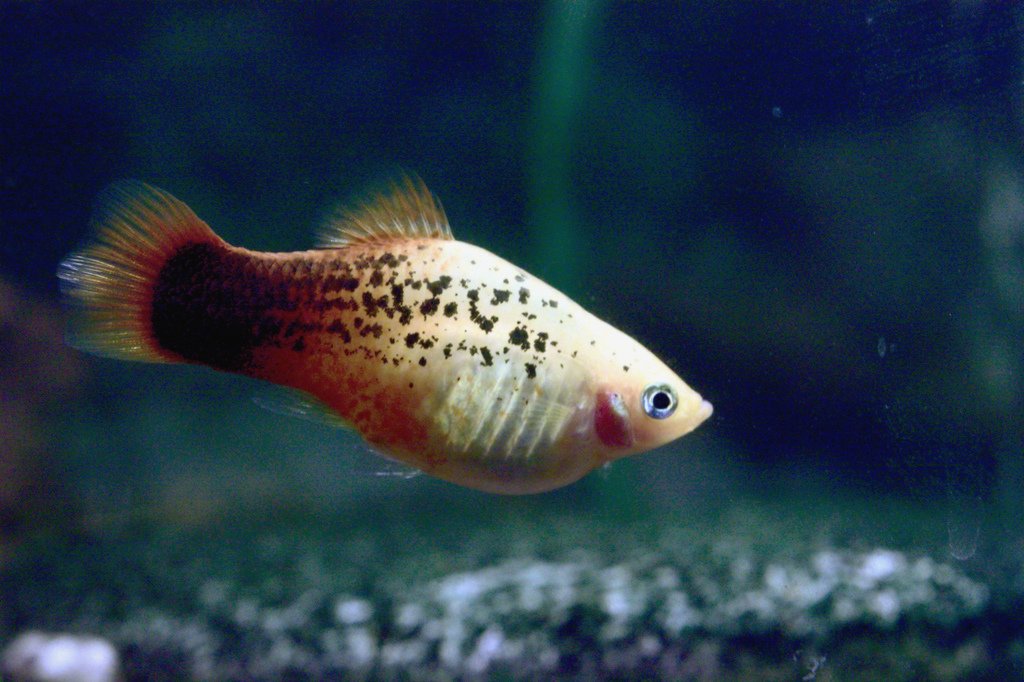
Platies, also members of the Poeciliidae family, are native to Central and North America. They were first described by Charles Frédéric Girard in 1859 and are loved by aquarists for their hardiness, peaceful nature, and wide range of colors and patterns.
| Scientific Name | Xiphophorus maculatus |
| Common/Market Names | Platy, Platies |
| Price Range | $2 – $5 per fish |
| Care Level | Easy |
| Breeding Level | Easy |
| Behavior | Peaceful, livebearer |
| Life Span | 3 – 5 years |
| Max Size | 3 inches |
| Water Volume | Minimum 10 gallons for a pair |
6. Swordtails
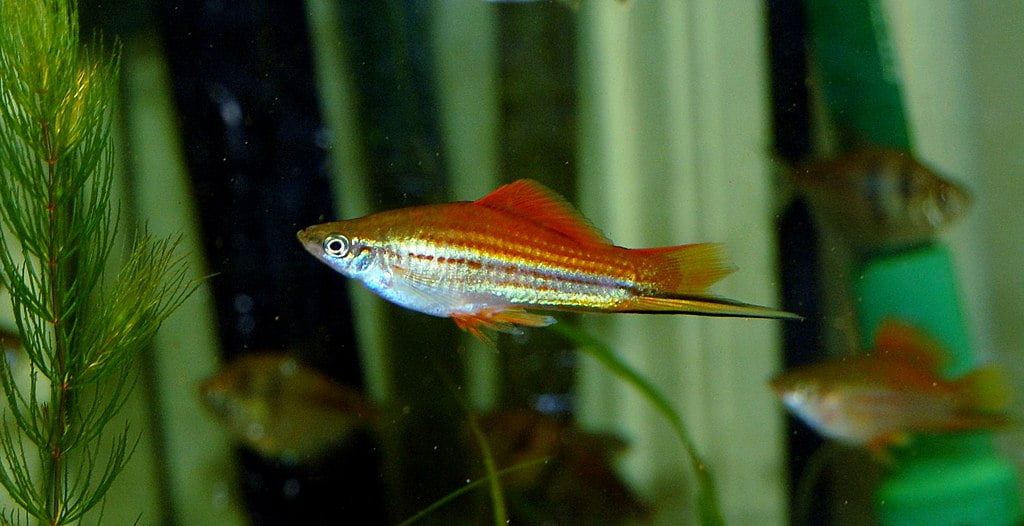
Swordtails are a member of the Poeciliidae family and are native to North and Central America. They are named for the elongated lower lobe of the male’s caudal fin, which resembles a sword.
| Scientific Name | Xiphophorus hellerii |
| Common/Market Names | Swordtail |
| Price Range | $3 – $6 per fish |
| Care Level | Easy |
| Breeding Level | Easy |
| Behavior | Peaceful, livebearer |
| Life Span | 3 – 5 years |
| Max Size | 5.5 inches |
| Water Volume | Minimum 15 gallons for a pair |
7. Zebra Danios
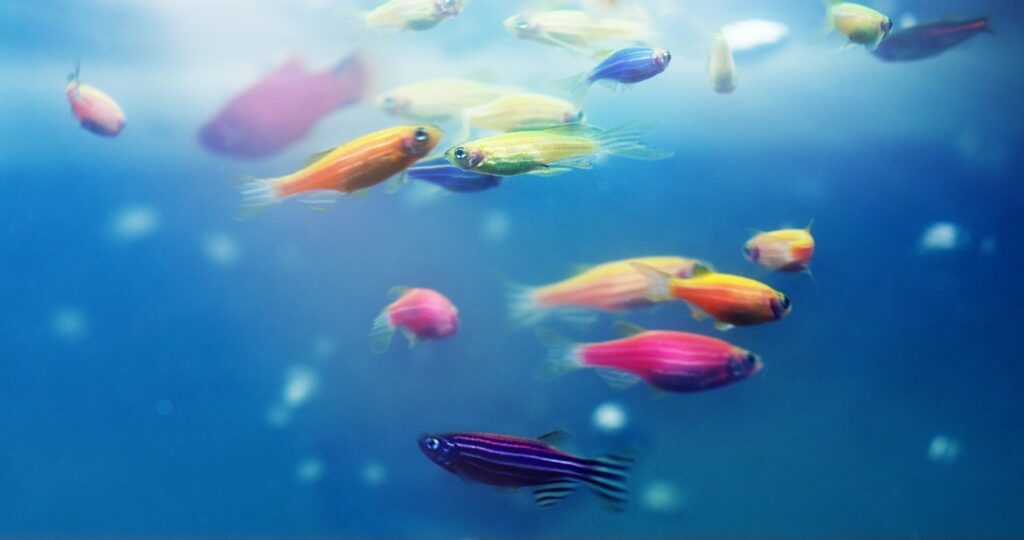
Zebra Danios, part of the Cyprinidae family, are native to South Asia. They were first described by Francis Buchanan-Hamilton in 1822 and have been a staple in the aquarium hobby due to their hardiness and active behavior.
| Scientific Name | Danio rerio |
| Common/Market Names | Zebra Danio, Zebrafish |
| Price Range | $2 – $4 per fish |
| Care Level | Easy |
| Breeding Level | Easy |
| Behavior | Peaceful, schooling fish |
| Life Span | 3 – 5 years |
| Max Size | 2 inches |
| Water Volume | Minimum 10 gallons for a school |
8. Cherry Barb
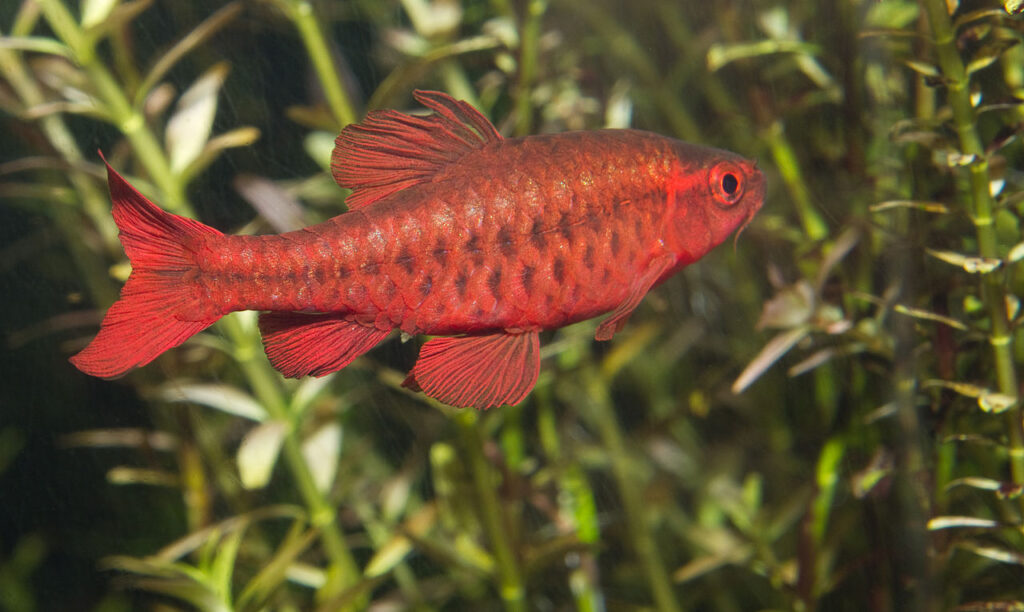
The Cherry Barb, a member of the Cyprinidae family, is native to Sri Lanka. They were first described by Francis Day in 1868 and are named for the male’s vibrant red color during spawning.
| Scientific Name | Puntius titteya |
| Common/Market Names | Cherry Barb |
| Price Range | $2 – $4 per fish |
| Care Level | Easy |
| Breeding Level | Moderate |
| Behavior | Peaceful, schooling fish |
| Life Span | 4 – 6 years |
| Max Size | 2 inches |
| Water Volume | Minimum 20 gallons for a school |
9. Harlequin Rasbora

Harlequin Rasboras are part of the Cyprinidae family and are native to Southeast Asia. They were first described by Albert William Herre in 1936 and are named for their distinctive black triangular patch.
| Scientific Name | Trigonostigma heteromorpha |
| Common/Market Names | Harlequin Rasbora |
| Price Range | $2 – $4 per fish |
| Care Level | Easy |
| Breeding Level | Moderate |
| Behavior | Peaceful, schooling fish |
| Life Span | 5 – 8 years |
| Max Size | 2 inches |
| Water Volume | Minimum 10 gallons for a school |
10. Rainbowfish
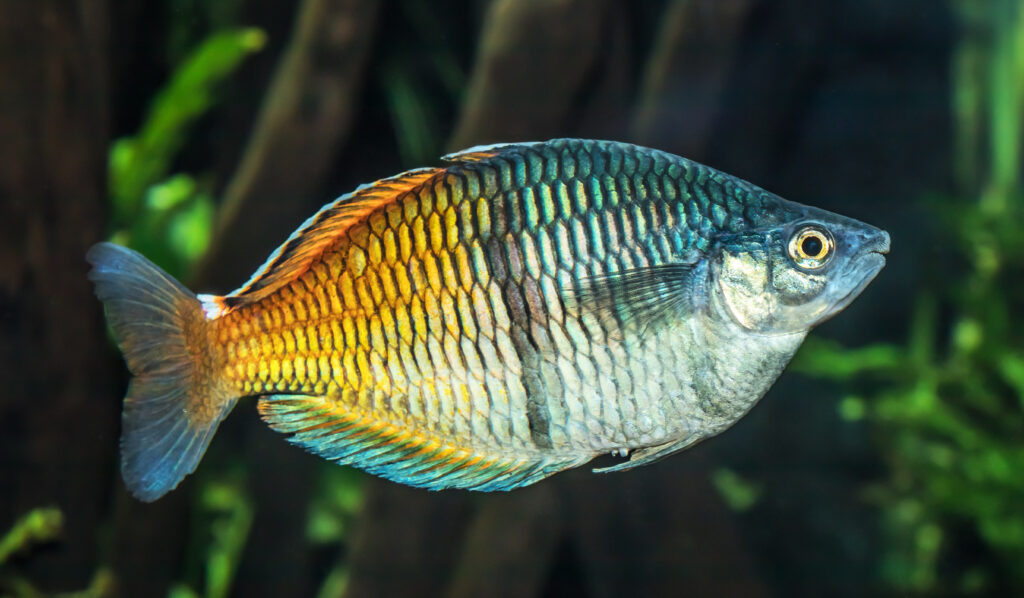
Rainbowfish are part of the Melanotaeniidae family and are native to Australia, New Guinea, and Indonesia. They were first described by François Pellegrin in 1904 and are named for their vibrant colors.
| Scientific Name | Melanotaenia spp. |
| Common/Market Names | Rainbowfish |
| Price Range | $5 – $20 per fish |
| Care Level | Intermediate |
| Breeding Level | Moderate |
| Behavior | Peaceful, schooling fish |
| Life Span | 5 – 8 years |
| Max Size | 6 inches (varies by species) |
| Water Volume | Minimum 30 gallons for a school |
11. Discus
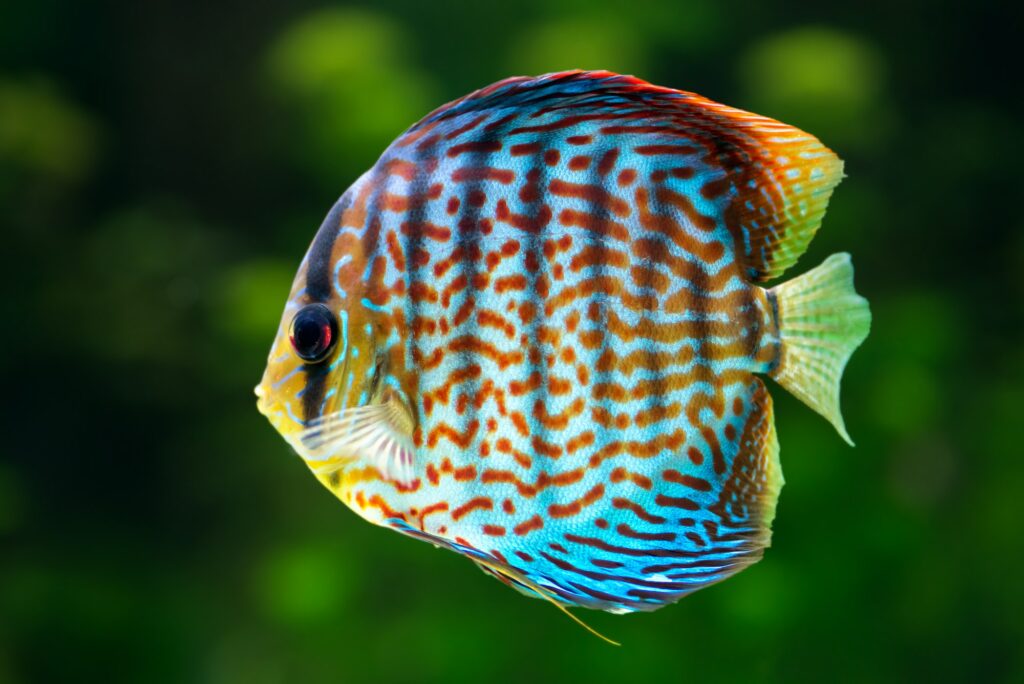
Discus are a member of the Cichlidae family and are native to the Amazon River basin. They were first described by Johann Jakob Heckel in 1840 and are known for their distinctive disc-shaped bodies and vibrant colors.
| Scientific Name | Symphysodon spp. |
| Common/Market Names | Discus |
| Price Range | $50 – $200 per fish |
| Care Level | Advanced |
| Breeding Level | Difficult |
| Behavior | Peaceful, prefers to be in groups |
| Life Span | 10 – 15 years |
| Max Size | 9 inches |
| Water Volume | Minimum 55 gallons for a pair |
12. Angelfish
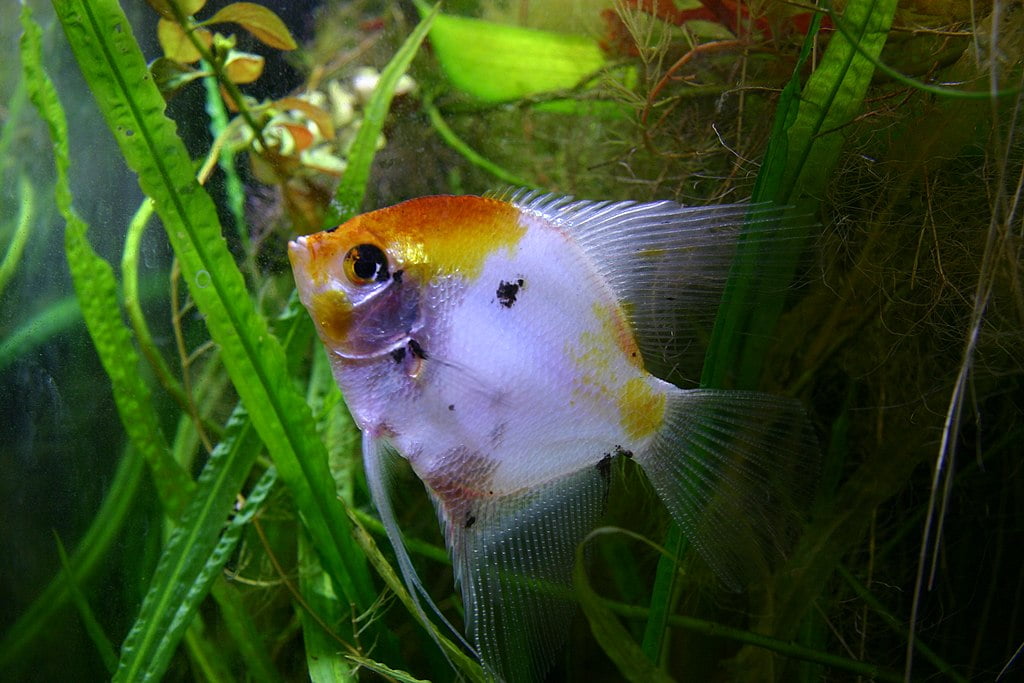
Angelfish, also part of the Cichlidae family, are native to the Amazon River basin. They were first described by Lichtenstein in 1823 and are named for their wing-like fins.
| Scientific Name | Pterophyllum scalare |
| Common/Market Names | Angelfish |
| Price Range | $10 – $30 per fish |
| Care Level | Intermediate |
| Breeding Level | Moderate |
| Behavior | Semi-aggressive, prefers to be in groups |
| Life Span | 10 – 12 years |
| Max Size | 6 inches |
| Water Volume | Minimum 30 gallons for a pair |
13. Betta
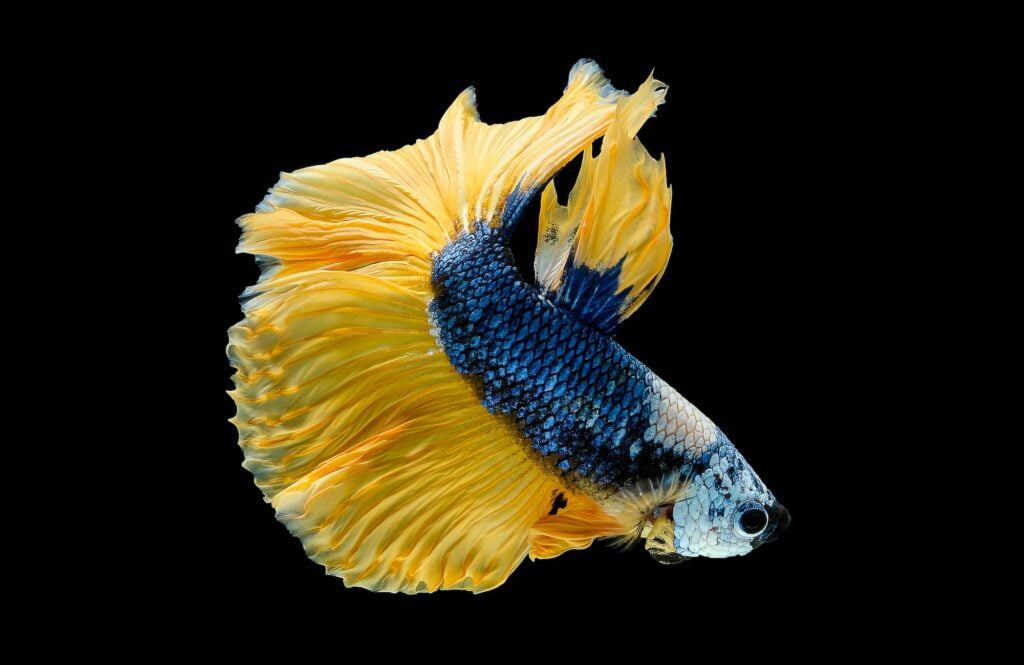
Bettas, also known as Siamese fighting fish, are part of the Osphronemidae family and are native to Southeast Asia. They were first described by Peter Artedi in 1751 and are known for their vibrant colors and long, flowing fins.
| Scientific Name | Betta splendens |
| Common/Market Names | Betta, Siamese Fighting Fish |
| Price Range | $5 – $50 per fish |
| Care Level | Easy |
| Breeding Level | Difficult |
| Behavior | Aggressive, solitary |
| Life Span | 3 – 5 years |
| Max Size | 3 inches |
| Water Volume | Minimum 5 gallons for one fish |
14. Dwarf Gourami
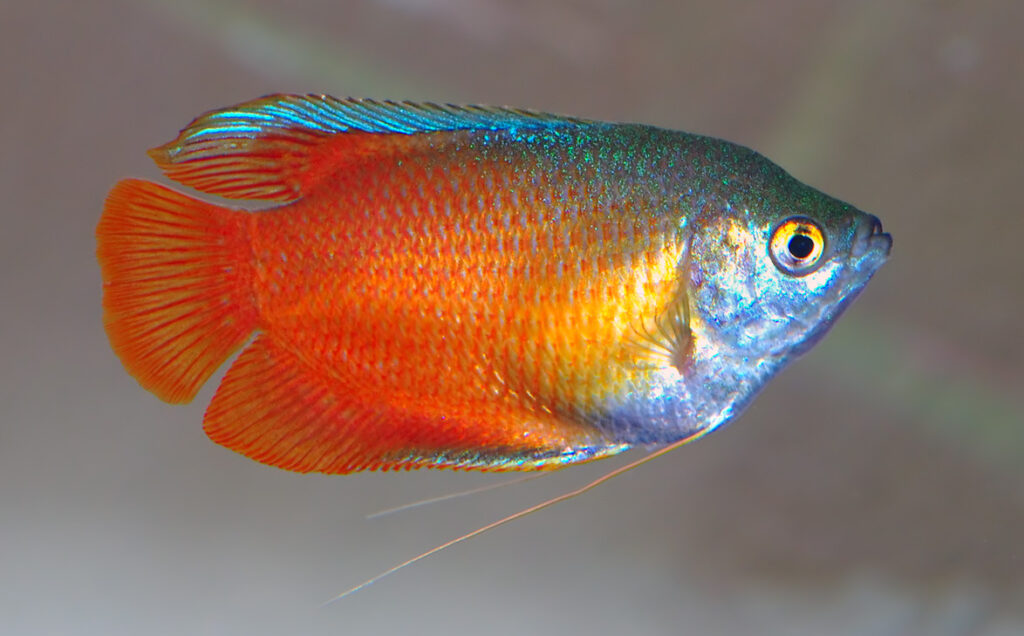
Dwarf Gouramis are part of the Osphronemidae family and are native to South Asia. They were first described by Albert Günther in 1861 and are known for their vibrant colors and peaceful nature.
| Scientific Name | Trichogaster lalius |
| Common/Market Names | Dwarf Gourami |
| Price Range | $4 – $8 per fish |
| Care Level | Easy |
| Breeding Level | Moderate |
| Behavior | Peaceful, prefers to be in pairs |
| Life Span | 4 – 6 years |
| Max Size | 3.5 inches |
| Water Volume | Minimum 10 gallons for a pair |
15. Pearl Gourami
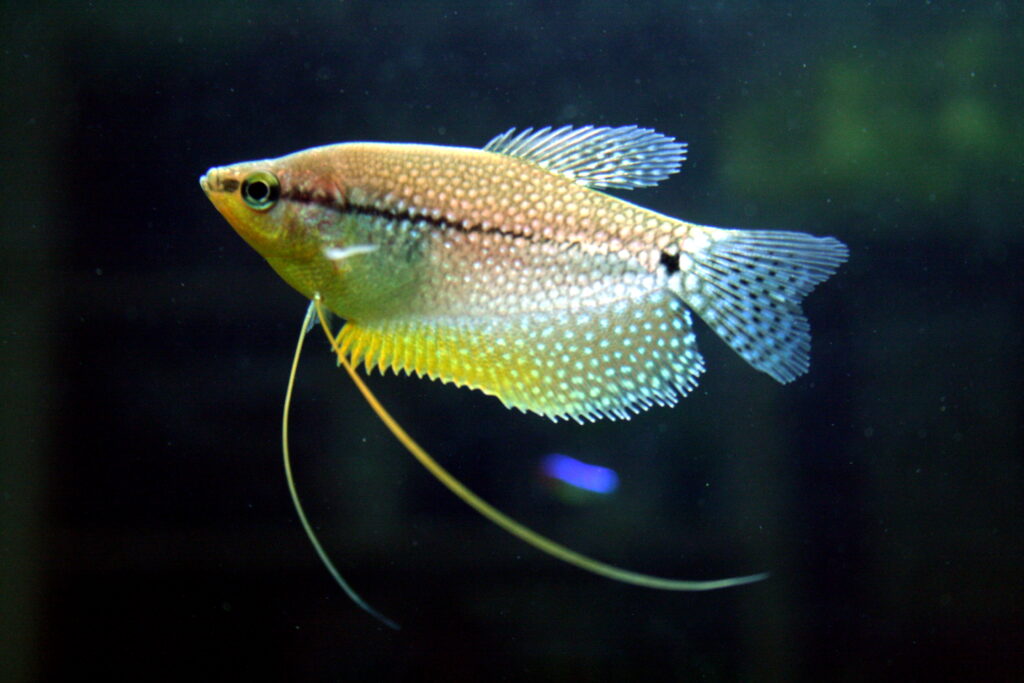
Pearl Gouramis, also part of the Osphronemidae family, are native to Southeast Asia. They were first described by Theodore Edward Cantor in 1849 and are named for their pearl-like spots.
| Scientific Name | Trichopodus leerii |
| Common/Market Names | Pearl Gourami |
| Price Range | $5 – $10 per fish |
| Care Level | Easy |
| Breeding Level | Moderate |
| Behavior | Peaceful, prefers to be in pairs |
| Life Span | 5 – 8 years |
| Max Size | 5 inches |
| Water Volume | Minimum 30 gallons for a pair |
16. Blue Ram Cichlid
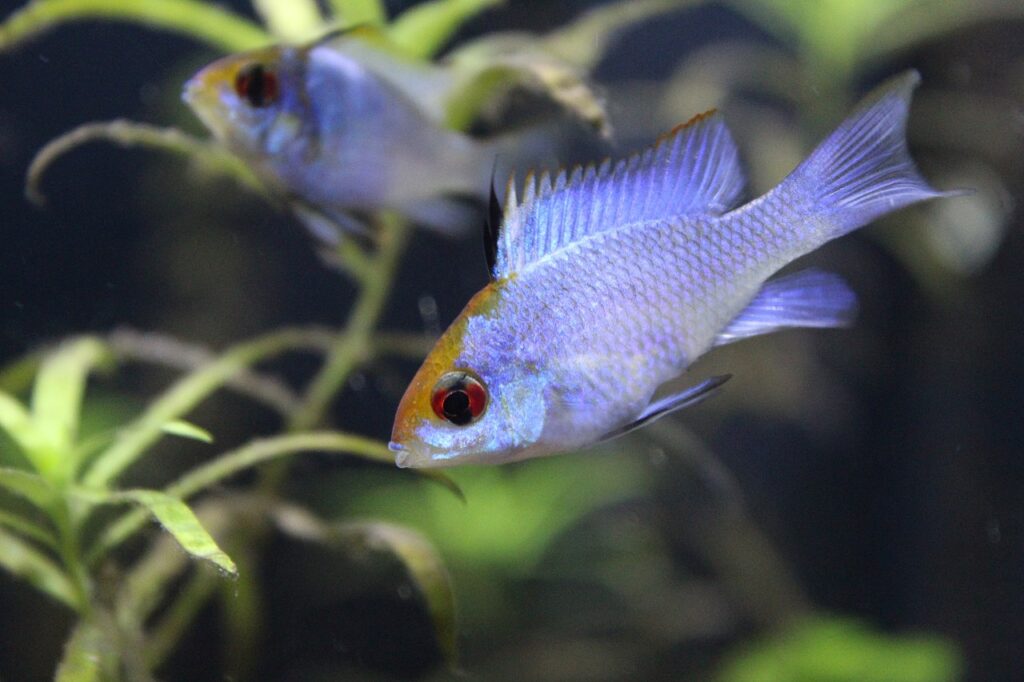
The Blue Ram Cichlids, or commonly referred to as German Blue Rams, belong to the Cichlidae family and are indigenous to the Orinoco River basin in South America. They were first described by George S. Myers and R. R. Harry in 1948 and are known for their vibrant colors and peaceful nature.
| Scientific Name | Mikrogeophagus ramirezi |
| Common/Market Names | Blue Ram Cichlid, German Blue Ram |
| Price Range | $6 – $10 per fish |
| Care Level | Intermediate |
| Breeding Level | Moderate |
| Behavior | Peaceful, prefers to be in pairs |
| Life Span | 3 – 4 years |
| Max Size | 3 inches |
| Water Volume | Minimum 20 gallons for a pair |
17. Bolivian Ram
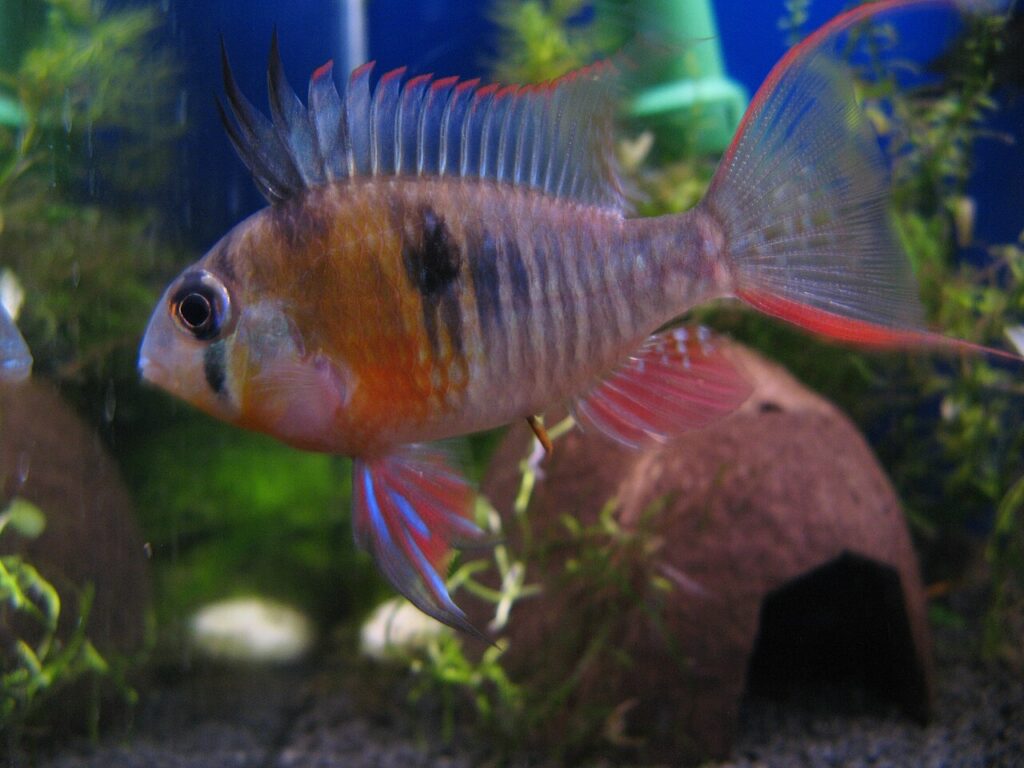
Bolivian Rams, also part of the Cichlidae family, are native to the Amazon River basin. They were first described by Jacques Pellegrin in 1904 and are known for their peaceful nature and interesting behavior.
| Scientific Name | Mikrogeophagus altispinosus |
| Common/Market Names | Bolivian Ram |
| Price Range | $6 – $10 per fish |
| Care Level | Intermediate |
| Breeding Level | Moderate |
| Behavior | Peaceful, prefers to be in pairs |
| Life Span | 4 – 6 years |
| Max Size | 3.5 inches |
| Water Volume | Minimum 30 gallons for a pair |
18. Kribensis Cichlid
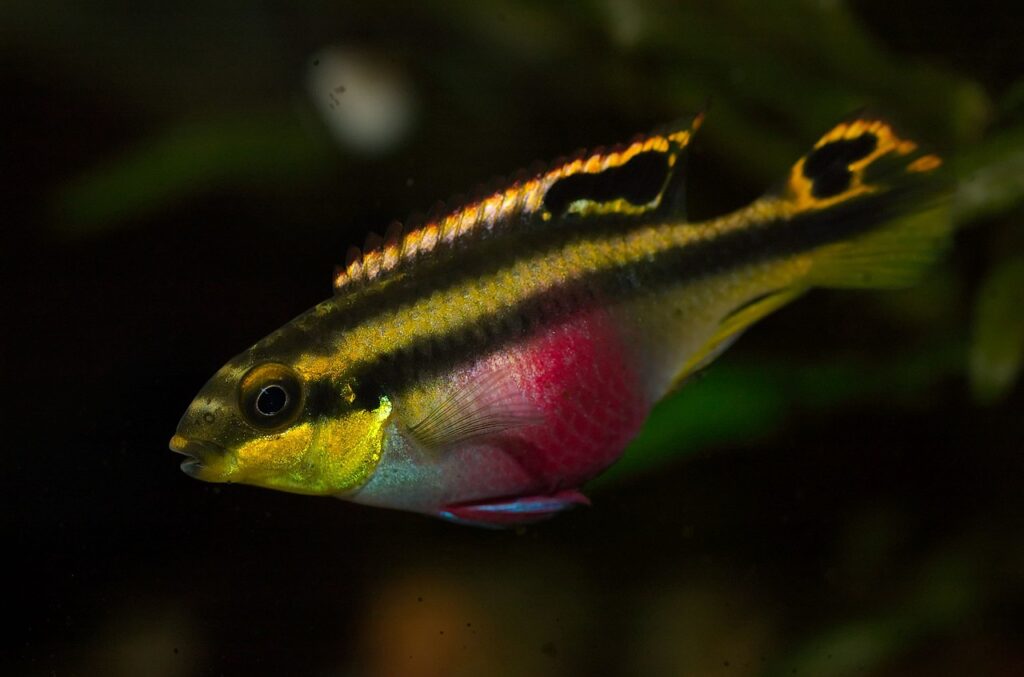
Kribensis Cichlids, part of the Cichlidae family, are native to West Africa. They were first described by George Albert Boulenger in 1911 and are known for their vibrant colors and interesting breeding behavior.
| Scientific Name | Pelvicachromis pulcher |
| Common/Market Names | Kribensis Cichlid, Krib |
| Price Range | $5 – $10 per fish |
| Care Level | Easy |
| Breeding Level | Easy |
| Behavior | Semi-aggressive, prefers to be in pairs |
| Life Span | 5 – 6 years |
| Max Size | 4 inches |
| Water Volume | Minimum 20 gallons for a pair |
19. Goldfish
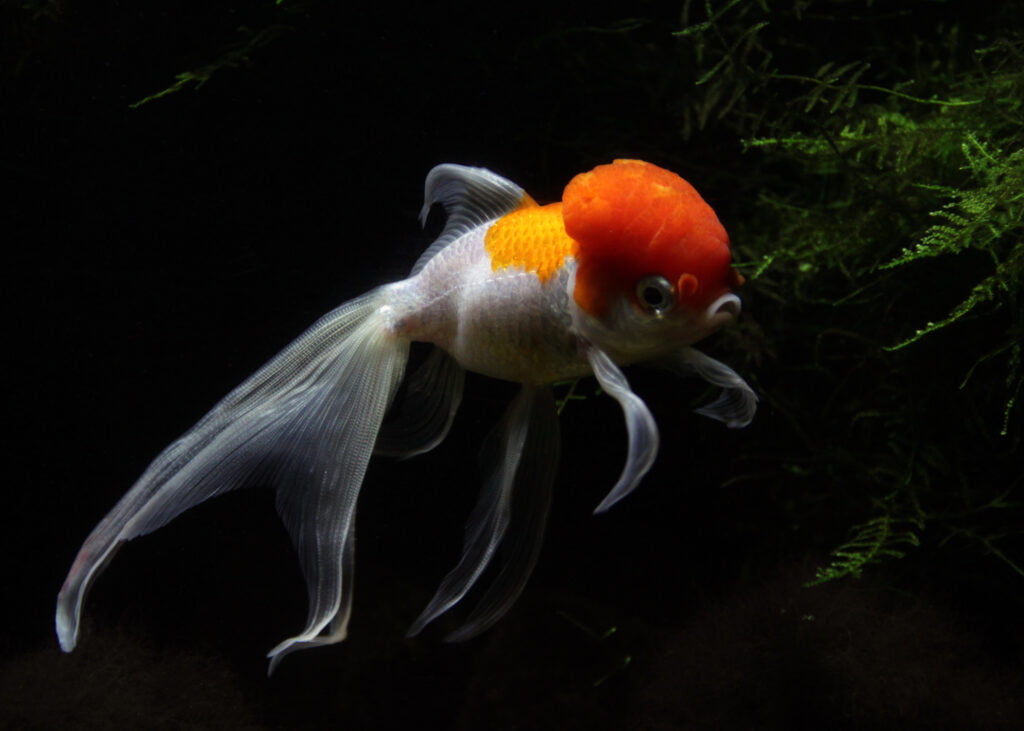
Goldfish, part of the Cyprinidae family, are native to East Asia. These mesmerizing creatures, originating in China over a thousand years ago, have been skillfully domesticated and have now emerged as an irresistible choice for aquarium enthusiasts worldwide. Their remarkable resilience and wide range of captivating hues and distinctive forms make them an irresistible sight.
| Scientific Name | Carassius auratus |
| Common/Market Names | Goldfish |
| Price Range | $5 – $100 per fish |
| Care Level | Easy |
| Breeding Level | Moderate |
| Behavior | Peaceful, prefers to be in groups |
| Life Span | 10 – 15 years |
| Max Size | Varies by variety, up to 14 inches |
| Water Volume | Minimum 20 gallons for one fish, plus 10 gallons for each additional fish |
20. Corydoras Catfish
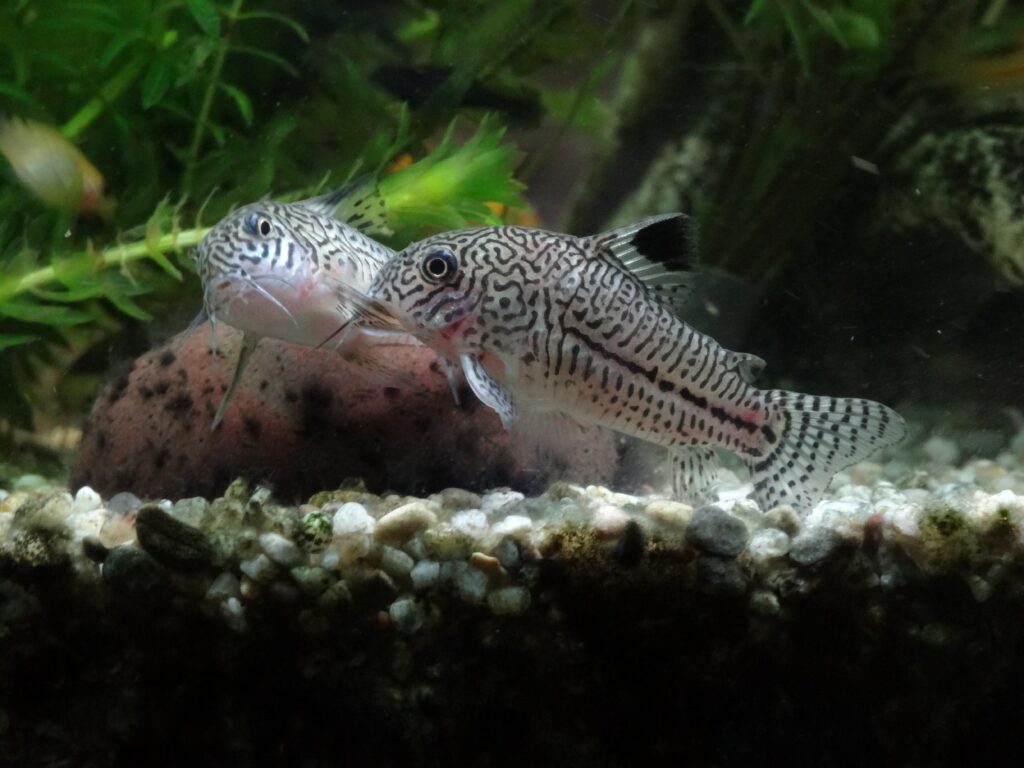
Corydoras Catfish, part of the Callichthyidae family, are native to South America. They were first described by Charles Tate Regan in 1912 and are known for their peaceful nature and interesting behavior.
| Scientific Name | Corydoras spp. |
| Common/Market Names | Corydoras Catfish, Cory Catfish |
| Price Range | $3 – $10 per fish |
| Care Level | Easy |
| Breeding Level | Moderate |
| Behavior | Peaceful, schooling fish |
| Life Span | 5 – 10 years |
| Max Size | Varies by species, up to 4 inches |
| Water Volume | Minimum 20 gallons for a school |
21. Otocinclus Catfish
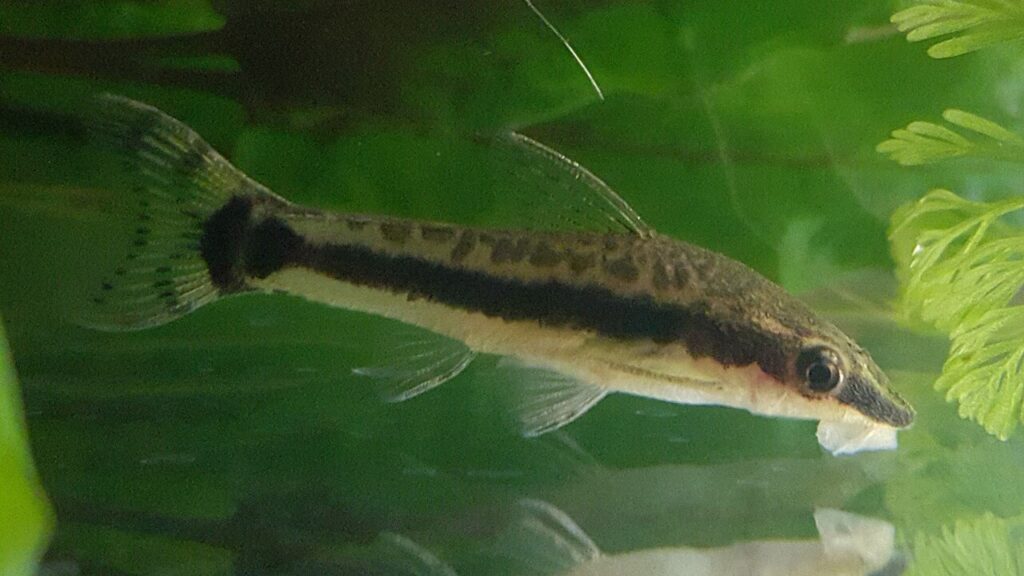
Otocinclus Catfish, also part of the Loricariidae family, are native to South America. They were first described by Carl H. Eigenmann and Rosa Smith Eigenmann in 1889 and are known for their algae-eating habits.
| Scientific Name | Otocinclus spp. |
| Common/Market Names | Otocinclus Catfish, Oto Catfish |
| Price Range | $2 – $5 per fish |
| Care Level | Intermediate |
| Breeding Level | Difficult |
| Behavior | Peaceful, schooling fish |
| Life Span | 3 – 5 years |
| Max Size | 2 inches |
| Water Volume | Minimum 20 gallons for a school |
22. Clown Loach
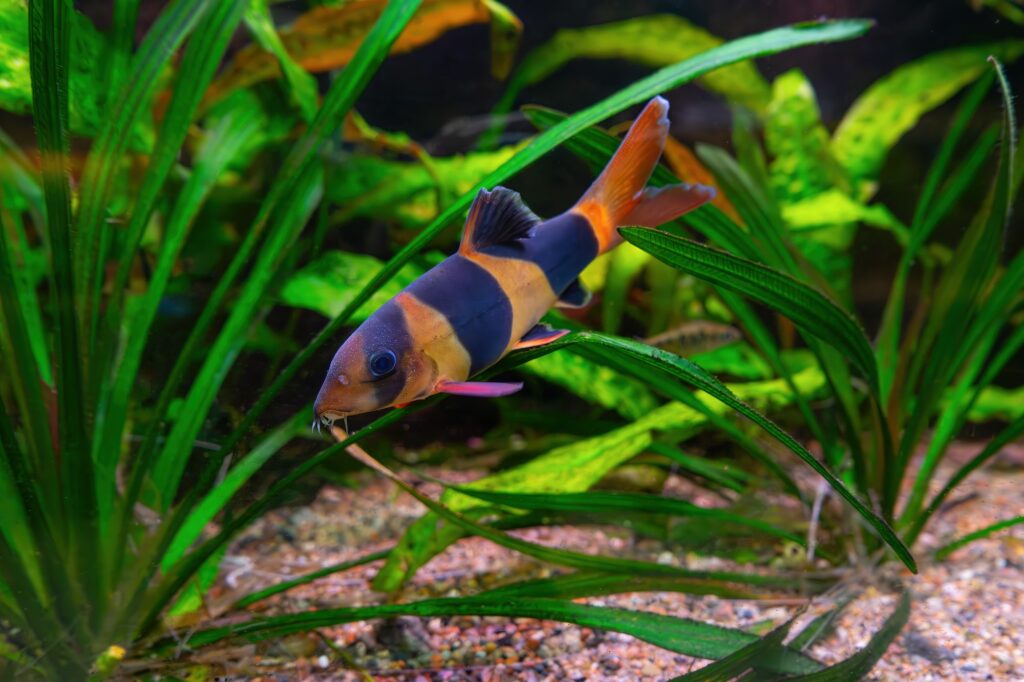
Clown Loaches are part of the Botiidae family and are native to the islands of Sumatra and Borneo in Indonesia. They were first described by Pieter Bleeker in 1852 and are known for their vibrant colors and unique behavior.
| Scientific Name | Chromobotia macracanthus |
| Common/Market Names | Clown Loach |
| Price Range | $10 – $20 per fish |
| Care Level | Intermediate |
| Breeding Level | Difficult |
| Behavior | Semi-aggressive, schooling fish |
| Life Span | 10 – 15 years |
| Max Size | 12 inches |
| Water Volume | Minimum 75 gallons for a school |
23. Kuhli Loach
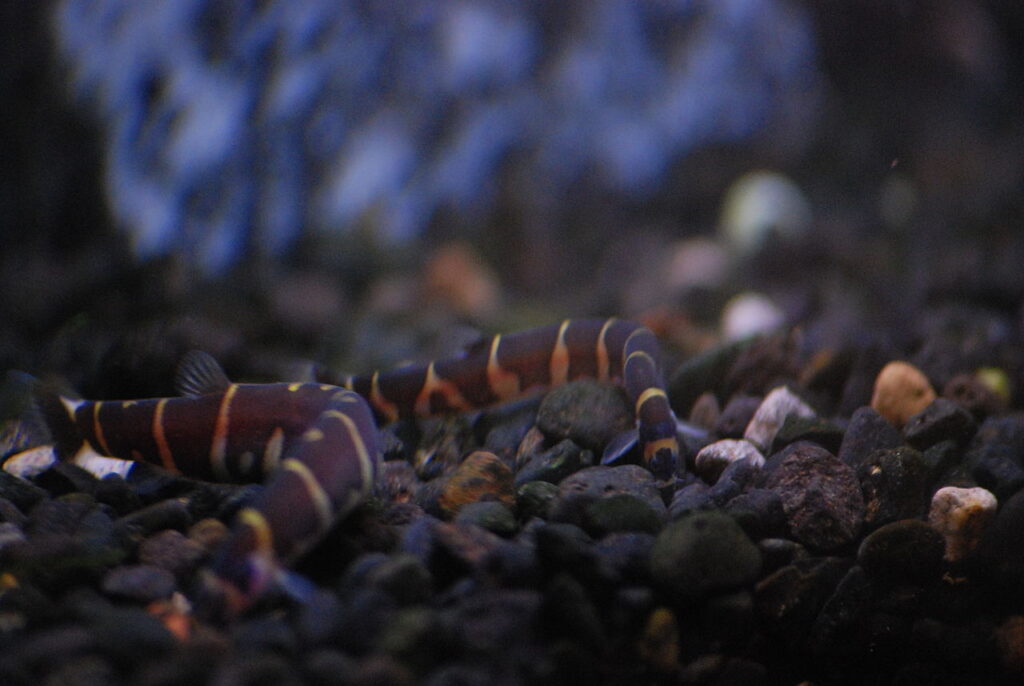
Kuhli Loaches, part of the Cobitidae family, are native to Southeast Asia. They were first described by Achille Valenciennes in 1846 and are known for their eel-like appearance and nocturnal habits.
| Scientific Name | Pangio kuhlii |
| Common/Market Names | Kuhli Loach |
| Price Range | $3 – $5 per fish |
| Care Level | Easy |
| Breeding Level | Difficult |
| Behavior | Peaceful, prefers to be in groups |
| Life Span | 10 – 15 years |
| Max Size | 4 inches |
| Water Volume | Minimum 20 gallons for a group |
24. Siamese Algae Eater
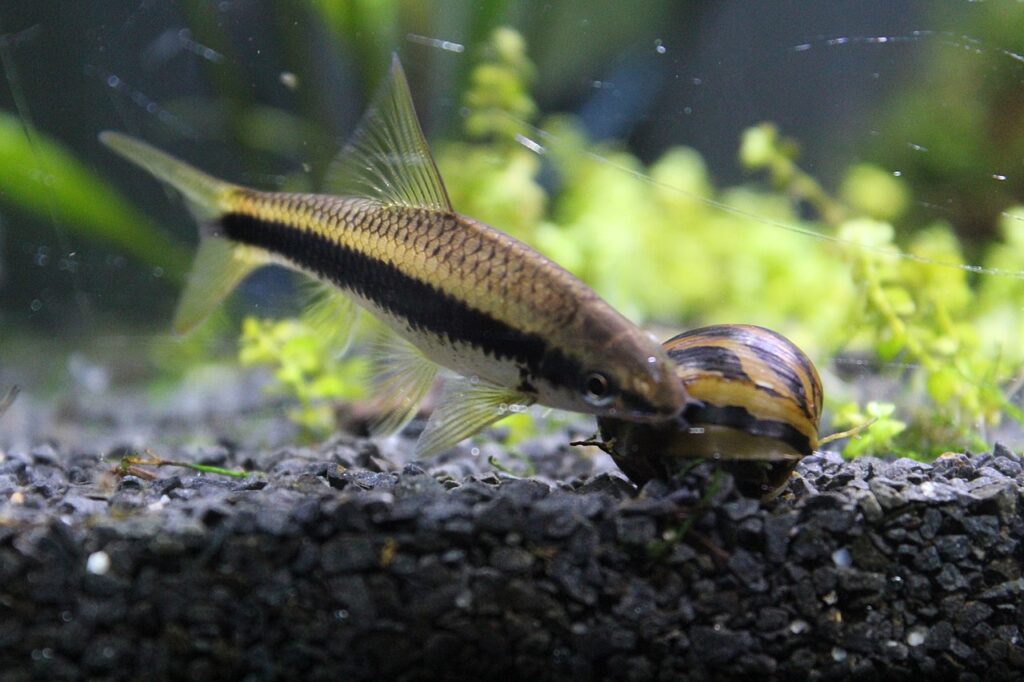
Siamese Algae Eaters, part of the Cyprinidae family, are native to Southeast Asia. They were first described by Tyson R. Roberts in 1982 and are known for their algae-eating habits.
| Scientific Name | Crossocheilus oblongus |
| Common/Market Names | Siamese Algae Eater |
| Price Range | $3 – $6 per fish |
| Care Level | Easy |
| Breeding Level | Difficult |
| Behavior | Peaceful, prefers to be in groups |
| Life Span | 10 years |
| Max Size | 6 inches |
| Water Volume | Minimum 20 gallons for a group |
25. Bristlenose Pleco
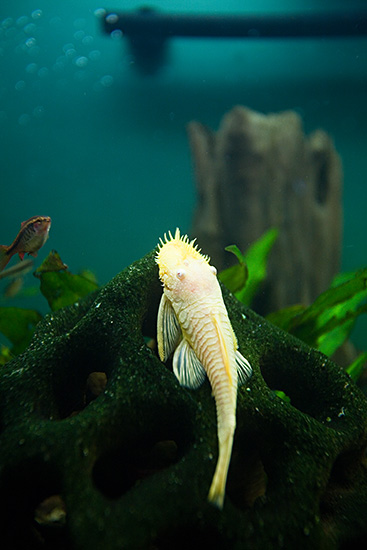
Bristlenose Plecos, part of the Loricariidae family, are native to South America. They were first described by Franz Steindachner in 1876 and are known for their algae-eating habits and unique appearance.
| Scientific Name | Ancistrus spp. |
| Common/Market Names | Bristlenose Pleco, Bushynose Pleco |
| Price Range | $5 – $15 per fish |
| Care Level | Easy |
| Breeding Level | Moderate |
| Behavior | Peaceful, solitary |
| Life Span | 5 – 10 years |
| Max Size | 5 inches |
| Water Volume | Minimum 20 gallons for one fish |
26. Endler’s Livebearer
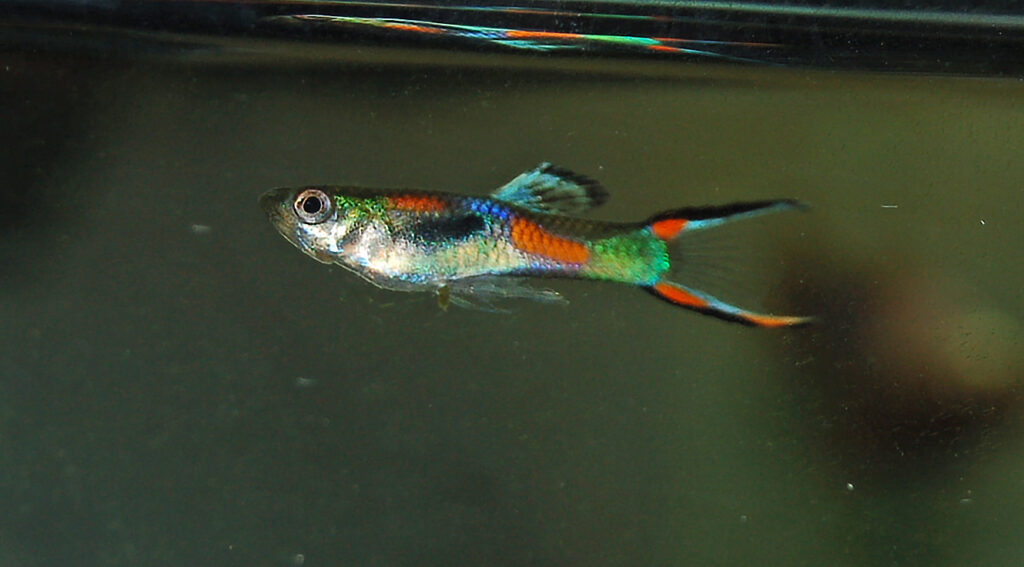
Endler’s Livebearers, part of the Poeciliidae family, are native to Venezuela. They were first described by John Endler in 1975 and are known for their small size and vibrant colors.
| Scientific Name | Poecilia wingei |
| Common/Market Names | Endler’s Livebearer |
| Price Range | $2 – $5 per fish |
| Care Level | Easy |
| Breeding Level | Easy |
| Behavior | Peaceful, livebearer |
| Life Span | 2 – 3 years |
| Max Size | 1.5 inches |
| Water Volume | Minimum 5 gallons for a pair |
27. Killifish
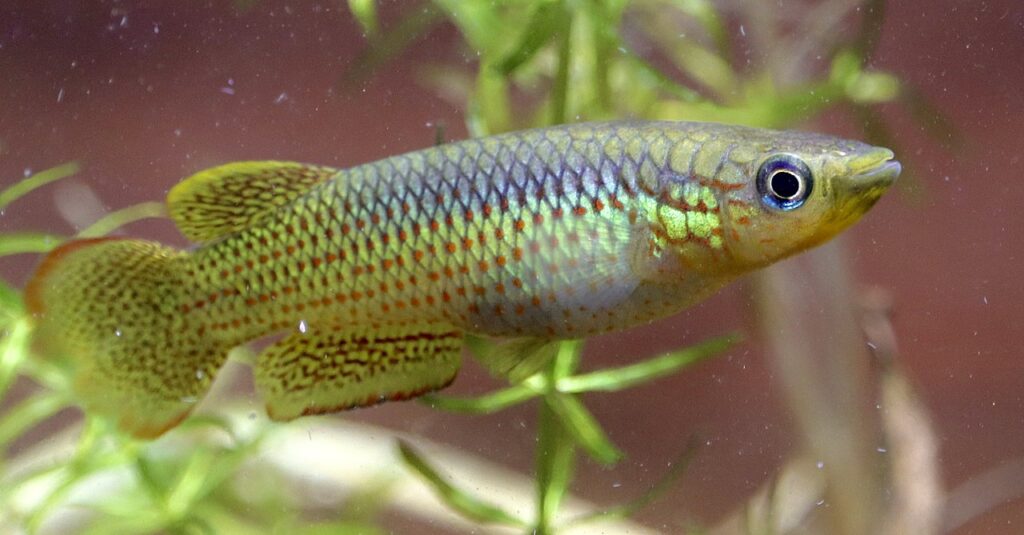
Killifish, part of the Cyprinodontidae family, are found worldwide, with the highest diversity in Africa and South America. They were first described by Carl Linnaeus in 1758 and are known for their vibrant colors and unique breeding habits.
| Scientific Name | Varies by species |
| Common/Market Names | Killifish |
| Price Range | $5 – $20 per fish |
| Care Level | Intermediate to Advanced |
| Breeding Level | Moderate to Difficult |
| Behavior | Varies by species, generally peaceful |
| Life Span | 2 – 5 years |
| Max Size | Varies by species, up to 6 inches |
| Water Volume | Minimum 10 gallons for a pair |
FAQs
Q: How many of these colorful fish species can I keep in one tank?
A: The number of fish you can keep depends on your tank size, filtration system, and the specific species you choose. As a general rule, follow the “one inch of fish per gallon of water” guideline for small fish, but always research the specific needs of each species you plan to keep.
Q: Are these colorful fish species suitable for beginners?
A: Many of the fish on this list, such as Neon Tetras and Guppies, are indeed suitable for beginners. However, some may require more specialized care. Always research the specific needs of any fish before adding them to your aquarium.
Q: How can I maintain the vibrant colors of these fish?
A: To maintain vibrant colors, provide a balanced diet rich in carotenoids, ensure proper water quality, and create a stress-free environment. Regular water changes, appropriate lighting, and a varied diet of high-quality fish food will help keep your fish healthy and colorful.